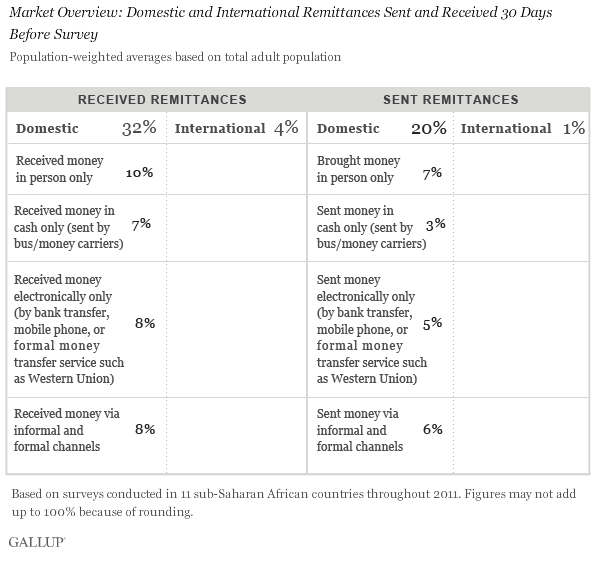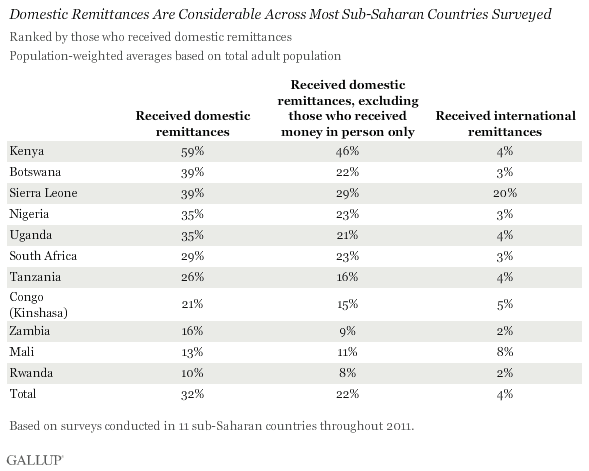This article is the second in a three-part series on payments and money transfer behavior of sub-Saharan Africans, highlighting the most pertinent results from a new Gallup study funded by the Bill & Melinda Gates Foundation.
WASHINGTON, D.C. -- Thirty-two percent of adults in 11 sub-Saharan African countries -- or about 80 million people -- received money from family members or friends living in a different city of their country in the 30 days before being surveyed in 2011, according to a recent Gallup study. This figure dwarfs the 4% of the total adult population (approximately 10 million people) in the 11 countries who received money from people in other countries in the same time frame.

The 32% of adults who received domestic remittances is the sum of respondents who only received money in person from a family member or friend (10%), received only cash sent by informal channels such as by bus or money carriers (7%), received money only electronically by bank transfer, mobile phone, or a formal money transfer service such as Western Union (8%), and received money via both formal and informal channels (8%).
It should be noted that as far as international remittances are concerned, respondents were explicitly asked to exclude money received in person. Even if people who only received money in person were excluded from the group of domestic remittances recipients, respondents in these countries were still more than five times as likely to receive domestic remittances as to receive international remittances.
Twenty percent of the total adult population in the countries surveyed (roughly 50 million people) reported having sent domestic remittances to family members or friends living in different parts of the country. This 20% is the total of respondents who only brought money in person (7%), only sent money in cash (3%), only sent money electronically (5%), and only sent money using informal as well as formal payment channels (6%). This compares with 1% (more than 2 million people) who sent international remittances -- excluding money brought in person -- with the majority of senders transferring money to another African country.
Domestic Remittances More Common Than International
In all sub-Saharan African countries surveyed, respondents were more likely to have received remittances from family members or friends living in different areas of the country than to have received money from abroad. This contrast is most pronounced in Kenya, where 59% of adults received domestic remittances in the past 30 days (46% when excluding those who only received money in person), compared with 4% who received international remittances.

Sierra Leoneans were the most likely to receive international remittances -- 20% reporting this -- with most receiving payments from countries outside of Africa. However, even in Sierra Leone, respondents were almost twice as likely to have received domestic remittances (39% vs. 29% when excluding those who only received money in person). There are some unique circumstances in Sierra Leone that might have an effect on receiving remittances, including large flows of migrant labor for mining. The timing of the survey in Sierra Leone also coincided with the harvest of major crops, which may have generated relatively significant flows of money before the survey period. Additionally, there still may be some internal displacement after the civil war that ended in 2002, explaining the high rate of domestic remittances residents are receiving in the country.
Across the region, only a handful of respondents sent money to another African country or to a country outside of Africa. Residents of Sierra Leone once again stood out with 7% having sent money to another country in the previous 30 days, while all other countries had 2% or fewer adults sending remittances externally. The large Sierra Leonean diaspora is likely driving this relatively high rate of international remittance sending.

Implications
While development policy has focused largely on international remittances in recent years, the rate of domestic remittances in all sub-Saharan countries surveyed exceeds that of international remittances, sometimes by a high multiple. Gallup's surveys in 135 countries between 2009 and 2010 show that this pattern also holds worldwide, even when the time frame is 12 months and the definition of remittances includes the sending and receiving of goods and money.
Sending money informally, in cash, often involves paying a bus driver to carry money in an envelope, or sending money with a friend who happens to be traveling the same direction, methods that can be slow, costly, and unreliable and put money in transit at risk of theft. The sizable proportions of adults in the 11 sub-Saharan African countries surveyed sending money via informal channels or carrying the money themselves over long distances to family members and friends reflect a high degree of need to improve access to a market for quality domestic remittance services across the region.
Read the complete report and questionnaire.
For complete data sets or custom research from the more than 150 countries Gallup continually surveys, please contact SocialandEconomicAnalysis@gallup.com or call 202.715.3030.
Survey Methods
Results are based on face-to-face interviews with 1,000 adults, aged 15 and older, conducted June-October 2011, in 11 sub-Saharan African countries. Regional totals presented in this article are population-weighted averages, accounting for the population size of a country. For results based on each sample of national adults, one can say with 95% confidence that the maximum margin of sampling error ranged from ±3.5 percentage points to ±4.3 percentage points. The margin of error reflects the influence of data weighting. In addition to sampling error, question wording and practical difficulties in conducting surveys can introduce error or bias into the findings of public opinion polls.
Gallup's coverage area includes entire countries, including rural areas. The sampling frame represents the entire civilian, non-institutionalized adult population. Exceptions include areas where the safety of interviewing staff is threatened, scarcely populated islands in some countries, and areas that interviewers can reach only by foot, animal, or small boat.
There were the following exceptions for this study:
- In the Democratic Republic of the Congo (Kinshasa), North and South Kivu, Ituri, and Haut-Uele in the eastern part of the country were excluded due to insecurity. The excluded area represents approximately 20% of the population.
- In Uganda, the northern region was excluded due to the presence of LRA rebels. The excluded area represents approximately 10% of the population.
- The northern part of Mali, mainly extreme desert with difficult access, and nomadic population is excluded. The excluded area represents between 5% to 10% of the population.
In Botswana and Zambia, the sample has a larger than expected proportion of respondents that have reported completed secondary education when compared to the data used for post-stratification weighting.
For more complete methodology and specific survey dates, please review Gallup's Country Data Set details.
